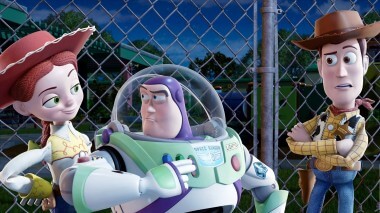Pixar and AnimationMentor.com’s Carlos Baena
If you are a student animator eager to work for the likes of Pixar or Dreamworks you may be forgiven if you find yourself thinking that the dream of working for the big hit factories is an impossibility. Especially if your animation course at the university of nowhere seems more interested in marking you on essays and how neat your file is presented, rather than how good you are at actual animation. The idea of ever becoming as good as a Pixar animator seems a far away imposibility and the secrets to animated achievement are kept behind closed doors.
Well luckily Carlos Baena, Sean Kelly and Bobby Beck, all seasoned animation professionals have got together to provide the “Animation Mentor” course which is centred around animation with the focus on becoming a professional animator with the necessary skills to have the likes of Pixar, Disney, Dreamworks, ILM, Sony and anyone else employing you for their latest work. Skwigly managed to catch up with Carlos Baena, industry veteran and Animation Mentor co-founder to discuss his work for Pixar as well as what makes Animation Mentor different to other programmes.

Thanks for talking to Skwigly about your career in animation. As a founder of the animation mentor program and also a successful feature film animator how difficult would you say it was to ‘break’ into the industry and work for the likes of ILM and Pixar? Was there a particular part of the road you took that you would say was invaluable?
Yes, it wasn’t easy. However, it’s expected given the competitive nature of this industry. It’s also gotten harder as the level keeps getting higher. I think for me the fact that it was a hard road and difficult to get there was what pushed me even harder. So I took it as a challenge. Everytime I’d get a rejection letter from any studio, I’m pretty sure there was a reason for it. As much as we don’t want to see it that way, it became clear to me I just wasn’t ready. So I’d go back and continue practicing. Motivation, practice and perseverance are important qualities in my opinion.
You have also worked in live action. As an animator you have complete control over a characters emotions, but working with live action you are at the mercy of the actors. When working in live action are you forced to work differently and do you miss the control you have in animation?
I definitely missed that. I had certain expressions and gestures in my head, and I just couldn’t get it. It’s different when working with adult actors that are experienced. Since I mostly worked with kid actors, some of them being in front of the camera for the first time, I found myself tricking the actors and having them think of specific things, in order to get a particular expression needed for the scene. In some cases it worked, in others it didn’t. But you try and hope for the best the next time.
Animation Mentor seems to have many successful grads who end up working in the top animation studios, what makes a animation mentor grad stand out from everyone else?
I’d say a combination of things. First, we’ve worked really hard in making sure they focused on the character/performance part of things. At the end of the day, that’s what studios (and audiences) want to see. To see a character come alive. And that’s no small task from experience. You can move and animate a character no problem. My mother can do that. But to give life to a character, to make a character feel, give it personality, not many people can. And we continue working towards that goal. An AM grad in my objective opinion not only has a great understanding of character/performance and mechanics, but hopefully will have a workflow that will make it easy for the studios and directors to give feedback/get the work and direction they need with a good work ethic, help towards their peers, finding ways to keep the inspiration going as hard as the work may be. The community at AM is definitely one of the things that has kept the grads together throughout the studios, as they are there for each other as I’ve noticed in many instances.
Take us through the journey of an animation mentor student, what kind of things will they experience and achieve?
Animation Mentor is a mix of a bunch of things. We’ve tried to make it fun and inspirational, but also very challenging from an animation standpoint. It’s not easy work, as it won’t be easy work once you are out in the industry, it’s a lot of hard work. We believed in mentorship as a way to transfer animation concepts. It’s something many of us wished we had back in college. We wanted to make sure we made it available to the students, even to those who aren’t able to travel to the U.S.
Animation Mentor is an 18-month online program designed to be taught virtually by some of the strongest professional animators at the leading studios. We broke it down in small groups of 10-14 students, using technology we purposely created to view/critique student work within an online campus (with Q&A sessions/video critiques archived for future reference for students, etc.). Students can download lectures and socialize in the same way they would on Facebook. We are constantly trying to stay up to date with technology, and as I write this we have some improvements I’m personally very excited about.
For those interested in learning more, here are links to the different courses at Animation Mentor:
There are so many subtle nuances in character animation and character animation is not limited to just humans. How does the animation mentor course encourage students to explore character in a way that differs from studying life from reading books, watching reference videos or going to life drawing class?
In the same way we chose to teach animation by getting out there. On the streets, in parks, in coffee places, Talking about real gestures, expressions, etc…or frame-by-frame movies ourselves, and showing this to the students. We basically try to transfer these animation habits in hopes that they take on these habits themselves, to avoid clichés, to take risks, to start from real moments of interaction to then apply them to their acting. The goal was always to not only teach animation/acting, but also think about how to build upon what’s been done already and push the envelope. Each actor is different. Each one of them brings something new and fresh to the table. It’s no different with animators. There is nothing more motivating than hearing a student tell you that they just wanted to animate things, but now they are thinking as actors, and bringing that into their characters.
If you were looking to be impressed by a showreel what exactly would you be looking for?
I compiled a while back a few tips in this link. However, things change pretty drastically in this industry sometimes. I’d say, the main ones:
- Keep it simple, short and to the point
- I want to see the animator knowing mechanics and a strong sense of acting/choices/ideas within the first few seconds. Don’t wait too long to get to the point.
- Don’t repeat things we’ve seen before (for example a particular studio style of animation). Show the artist/personality behind the performance and be original.
- Don’t add distractions (choice of music, packaging choice,etc)
- The main point is the work on the reel. Titles, music, etc. are secondary.
- Impress the viewer right away.
- Show taste/appeal in the presentation
In Toy Story 3 you were given the task of animating ‘Spanish Buzz’ who displays quite a flair for flamenco an unmistakable charisma about him. For me it’s the comedic highlight of the film. How did you go about creating such a wonderful performance?
Thank you. I think it was a mix of things. I can’t take credit for it all, as there were a few other animators involved in the process as well. I think what helped was the following. A Director (Lee Unkrich) willing to take a chance on this character to do something different. That opened the door to so many things, and the character wouldn’t be the same if it wasn’t for Lee. Also, a lot of studying different things, such as Flamenco dance styles, comedic actors, previous work done on the character of Buzz Lightyear, which already helped set the basis for the character. Then, and this is a big one, feedback. The character wouldn’t be the same if it wasn’t for the help of the other animators and their feedback as I was animating the shots. In the end, I couldn’t be more proud of both that film, everyone involved in it and so many of the characters throughout.
Tom Hanks announced that Pixar are making Toy Story 4 and Pixar have announced the “Untitled Dinosaur Movie” and the equally untitled movie that takes place inside the human mind, what can you tell us about these?
I wish I knew, but I don’t.
Unfortunately, due to confidentiality agreements, even if I knew I couldn’t comment.
What are you working on at the moment? Did you have the chance to work on or have you seen much of Brave?
I worked for 9 months on pre-production on Monsters Inc 2. This past summer, I decided to take a leave of absence and focus my time in two personal projects. One animated and another one live-action.
What does the future hold for Animation Mentor?
Animation Mentor is continuously evolving as the industry continues to evolve. I’m very excited about the future improvements as well as where it’s headed in general. I think the students are going to be surprised. Additionally, we continue working on ways to make the education experience be a unique one. That in itself is always a challenge. As the students continue pushing the art form, it’s only going to help take our industry to the next level.



